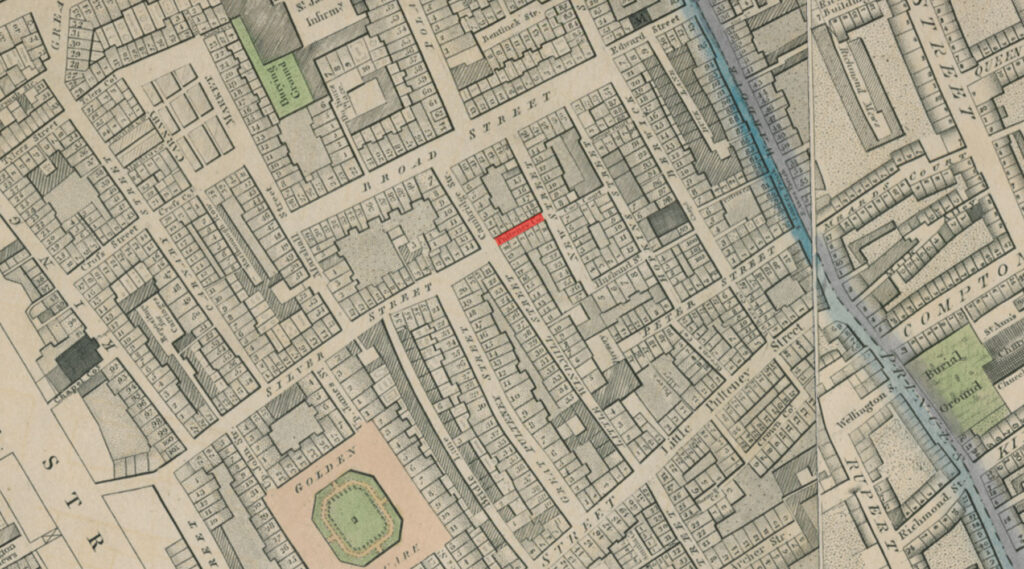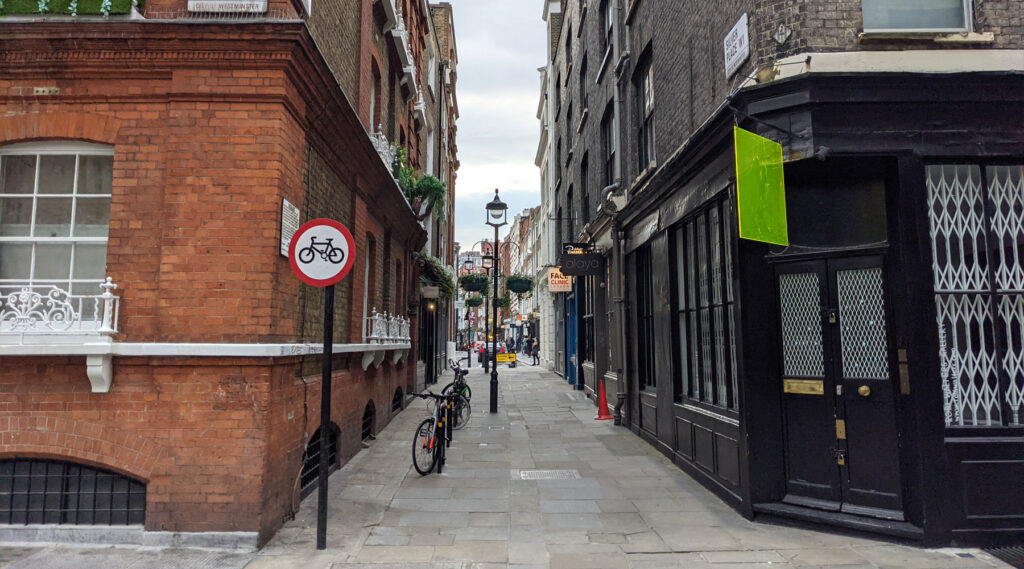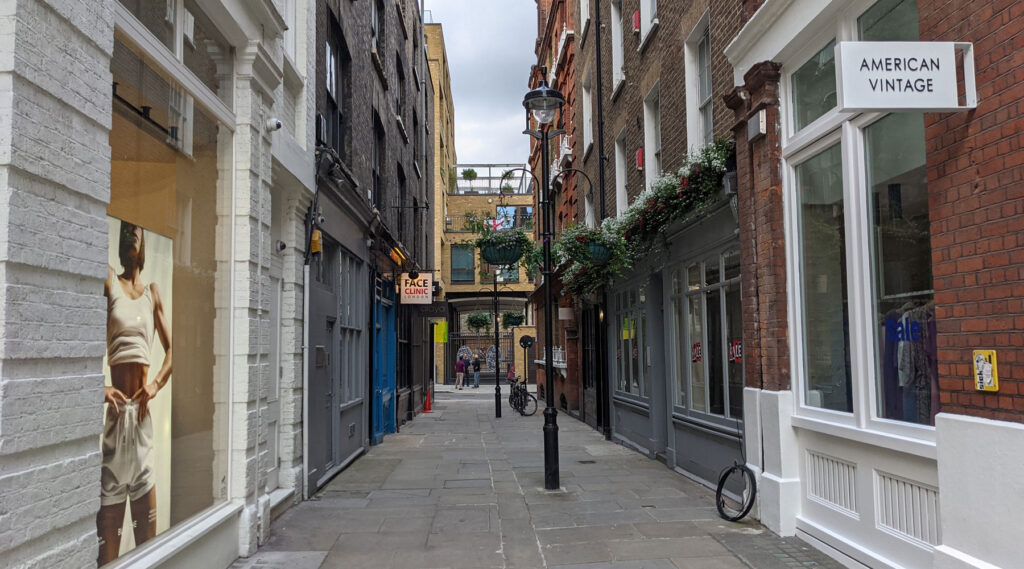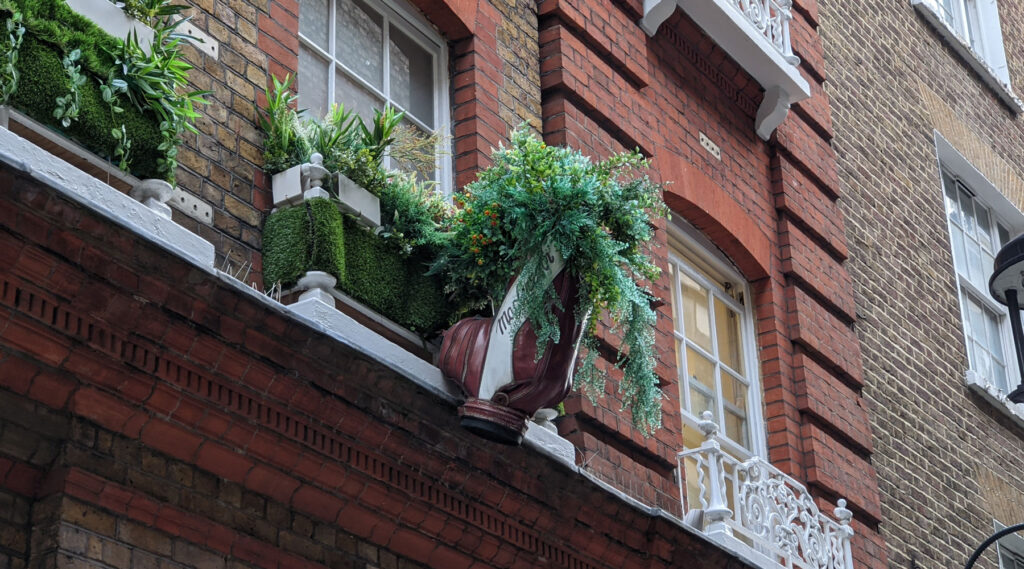A short wide alley in Soho lined with Georgian and Victorian buildings, but also a link to one of the 19th-centuries worst terrorist attacks.
This patch of Soho was once fields, known as Colman Hedge Close, but started being developed in the second half of the 17th-century. The layout of the area hasn’t changed much, but the street names have. When first laid out, the alley was known as Pulteney Court, but most of the streets in the area were renamed in the mid 19th-century, and that’s when it became Silver Place.
The name Silver Place was probably chosen as it runs on from what used to be called Silver Street, but is today Beak Street. It’s suggested that the former Silver Street was so named as it’s one block from Golden Square.
The buildings that line most of the alley are all from the earliest development, and date to around the 1720s and are laid out as three floors above a row of shops.
The newish looking building opposite the end of the alley is Trenchard House, and is residential flats built on the site of a 1930s police section house that was vacated in 1999 and provided hostel accommodation for police officers. However, the previous building on that site is notable, a large brewery that has a link to Dr John Snow of cholera fame. While he is noted for discovering that cholera was water-borne rather than airborne thanks to realising that a single water pump was causing infections in one part of Soho but not another, less well known is that cholera outbreak took place around the brewery, but no one in the brewery was getting ill.
They were drinking small beer, and although they didn’t know it at the time, that was killing off the diseases in the water.
The alley has had a mostly quiet life, but in 1867 it became involved in a notorious act of terrorism — the Clerkenwell explosion.
Members of the Irish Republican Brotherhood, nicknamed the “Fenians”, were being held at Clerkenwell prison in December 1867. An attempt to rescue them by blowing down the wall with gunpowder went disastrously wrong, as 12 people living in the houses around the prison were killed and 120 people were injured.
The bombing was later described as the most infamous action carried out by the Fenians in Britain in the 19th century.
A number of people were arrested, and five were put on trial. According to the trial evidence, Curtis and Harvey, gunpowder manufacturers sold some powder to be delivered to Pulteney Court (as it was still called then) in 4 barrels, one of which was stored in 8 Pulteney Court, and the rest around the corner in Golden Square.
Witnesses also reported seeing the key defendant, Michael Barrett in Pulteney Court. In the end, Barrett was found guilty and he was the last man to be publicly hanged in England.
The alley has been rather less notorious since then.
A decade after that dreadful incident, the local parish bought the corner buildings and built Pargiter Court as housing for local working people. A notable design feature is the iron railings in front of each window, designed to “encourage a taste for window gardening”.
In 1985 the flats were acquired by the Soho Housing Association and are now used to provide sheltered accommodation for elderly residents.
A few occupants have recently started window gardening again, as it was looking rather barren a few years back, but now quite a few windows have turned green, including one that has acquired a golfing bag as an adornment.











The Clerkenwell explosion took place in Corporation Row, and the reason it was so disastrous was that the explosion took place directly above a gas main. After the Prison closed in the 1880s the Sir Hugh Myddelton School (now converted to housing) was built on the site.
Many of the crowd who witnessed the public hanging of Michael Barrett travelled by that new-fangled invention, the Underground (the Metropolitan Line had opened to nearby Farringdon five years earlier). You can almost imagine the posters: “Executions by Underground”.
The link with the Clerkenwell explosion is fascinating, thanks for that story. Pargiter Court was originally St James’s Dwellings. Name and foundation stone dated 26 July 1886 on the Ingestre Place frontage as well as a Westminster coat of arms.